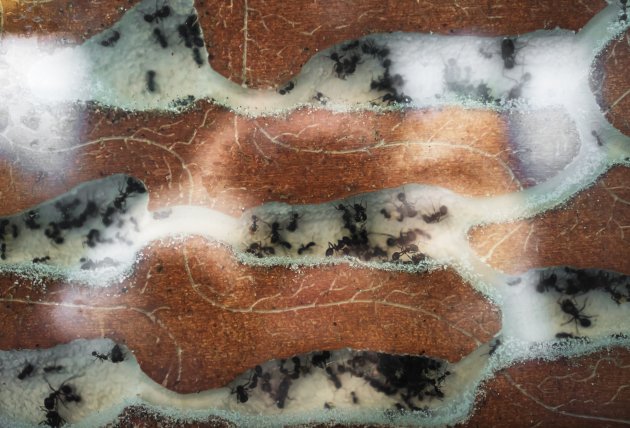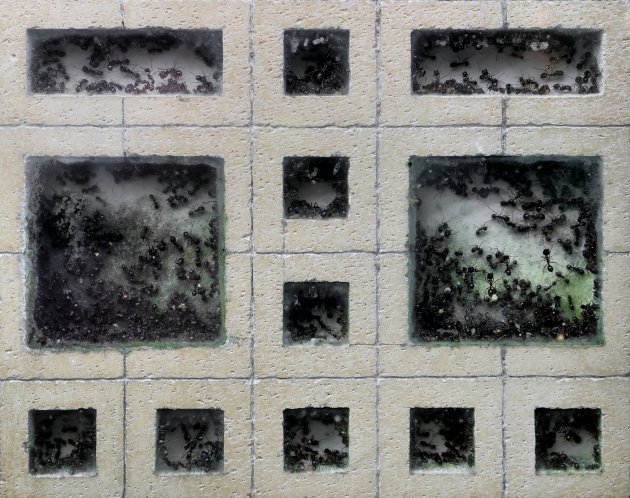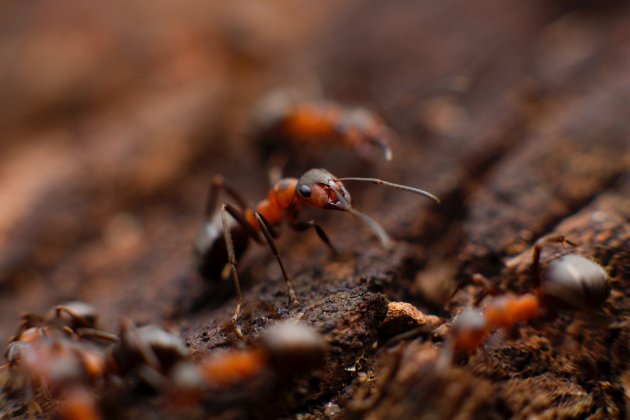Ant keeping has become a popular hobby among families devoted to nature! Even though ants are not traditional pets, we can still learn plenty from watching ants interact and amaze ourselves at their capacity!
Here at Pet Comments, we’ll introduce you into the world of ant keeping. Have in mind that there more than 10,000 species of ants in the world! We will only cover a few of the most common ants kept as pets and a few aspects of ant keeping.
Basic info
Ants, together with bees and wasps, belong to the family of the Formicidae. Ants’ bodies are divided into three pieces: head, thorax, and abdomen. They have six legs and two antennas. Their color depends on the ant species as so does the size.
The Dinoponera is the largest ant in the world, it measures a good 3cm to 4cm long and the Carebara atoma is believed to be the smallest in the world measuring a millimeter long.

Ants have their own organized structure. Depending on the species, a colony is composed of one or many egg-laying queens. The queen will produce workers and soldiers for the colony (all sterile females); In mating season the queen produces winged males and females to establish new colonies.
Popular ants among ant keepers
There are more than 10,000 ant species in the world; before picking one to start an ant colony we strongly encourage you to choose a queen ant from a local species. Not doing this could have terrible consequences; for example, if your ants escape their formicarium and expand in your area, they could potentially damage your local natural ecosystem. Therefore, choose to have ants that are already part of your local natural ecosystem.
Fire ants (Solenopsis invicta): This species of fire ants isn’t really native to North America, but rather from South America. Still, these guys made North America their home. Fire ants can also be found in Australia and some parts of Asia. Fire ants eat dead insects, earthworms and even mammals. These ants are of a copper brown color and their size goes from 2 to 6 mm. Fire ants’ sting is strong enough to persuade a novice owner away from starting their colony with this ant.
Black Carpenter (Camponotus pennsylvanicus): Is native to Eastern and central North America. You can find them especially to the east of the Rocky Mountains in woodlands and suburban communities. Black carpenter ants are larger in size than other species. These ones are of black color with light colored hairs on its abdomen. The male of the specimen has wings and flies as so does the queen, workers don’t have wings. Contrary to popular belief, these guys don’t eat wood. Their diet consists of both dead and living insects; if you drop meat and other kinds of sweets in their formicarium they will also devour it.
Pavement ant (Tetramorium caespitum): Is originally from Europe but, like other species, was introduced in North America as a pest. This ant is more aggressive towards other ant species than others going as far as “conquering” other ant’s colonies. Their name comes from their custom of living under the pavement. They eat other insects, seeds, meat, bread, sweets, and nearly everything. Pavement ants are dark brown - almost black.
Black garden ant (Lasius niger): Black garden ants are native from Europe, but they can be found in parts of North America, South America, Australia, and Asia. Just like their name implies, you can find this species of ant in gardens living under flower pots, and it is common to see them in urban areas. They eat small insects, leftovers and honeydew. These ants are perfect for a novice owner because they don’t bite or sting humans, they are long lasting and very easy to find.
If you are not in North America or wish to have an ant colony of a different species (local to your country or state), you can use Antmaps.org to locate and investigate all the species in your area.

Why should you have ants as pets?
Extremely low maintenance
Ants must be like the lowest maintenance pets ever! Think about all the time dog and cat owners spend taking their pets for a walk, playing with them, bath times, not to mention all and every single product necessary for the care of their pets.
Ants, on the contrary, don’t need a bath, don’t need constant attention, they don’t need to eat three times a day, etc. If you want to be expensive with your ant colony you can buy them a super fabulous formicarium online. But, this is not necessary because you can just make one on your own with easy to acquire materials.
Convenient size
Thinking you can’t have a pet in your small apartment? No worries. Unless you own an ant colony of MILLIONS of workers, your formicarium will probably fit in your room or any other place you wish to keep them.
Extremely clean
Forget about cleaning duties (ahem! except your own, obviously). Ants clean up after their own, they are so well organized they have their own cleaning method and system. Of course, maintenance is necessary at least once every few months and cleaning at least once in a week. This is as low maintenance as you can get.
Inexpensive food
What ants eat depends on the species. A mix of water and a few drops of honey, seeds, small insects like crickets, or fruit are some of ant’s most popular choices of food. How much food the owner will give to the ant colony depends on the size of the colony.
Witness the start of a new civilization
Yes, this is just as epic as it sounds. Having an ant colony is exactly like having a tiny city! They have their very own unique problems and ways to solve them, by observing them you can learn a lot and meditate on different matters. Learn to love and connect with nature by watching your ants interact with each other and create an organized routine.
Housing ants

Home size
Housing your ants can be as simple or as complicated as you want, depending on your ant colony size. At the earliest stages of your ant colony (when you only have the queen ant alone) a glass test tube “sealed” with cotton is enough housing. Ants are not demanding at all, but when your colony goes beyond 25 workers a larger new home is in order.
Formicarium structure
A proper ant colony home is called a formicarium. A formicarium is divided into two sections, the nest and the “outside” area. The nest is where the queen and other ants live and is almost like their private chambers. The “outside” area is where ants drop their own garbage and where you can put their food.
A formicarium that is designed to look like a terrarium is very traditional. To make one, the container must be filled with substrate and add decoration either artificial or natural. This formicarium design is the best choice to house a queen.
A sandwich style formicarium is designed for the study of ants. This formicarium structure is vertical and favors the observation of ants, hiding nothing to the eye. Unfortunately, this type of formicarium does not make the queen ant feel comfortable, so it’s not suited for keeping a queen ant.
If you do choose to have this type of formicarium it is advised to cover it once you’re not watching them, that way the ants and especially the queen ant will come back to feeling safe and secure.
Formicarium materials
A proper formicarium should be made of a square transparent plastic box which is to be filled with the substrate. The type of substrate you decide to use for your ants’ formicarium should entirely depend on your ant species. Do some research into the natural environment of your ant colony and use the type of substrate that comes closer to their natural environment.
Sand is the most common one, and also the easiest one to work with. Soil is the most natural one and it comes with the additional benefit of having nutrients from which the ants can take advantage of.
Gel is another substrate manufactured especially for ant keeping, is edible, and filled with nutrients. This type of substrate may be frowned upon for being artificial, but is completely safe for your ants.
A place for the formicarium
Once you have decided on a place in your home for your ant formicarium…you CANNOT move it! If you do, all of the tunnels carefully constructed by the ants will collapse. Therefore, when looking for an appropriate space for your ants to feel comfy, think wisely.
Don’t put the formicarium close to TVs, stereos, or anywhere close to loud noises. Ants communicate through vibrations and other vibrations disturb them. Temperature is important for them. Keep their nest away from direct sunlight and find an area close to 70 degrees Fahrenheit.
Take care of them!
Once your young ant colony is secure and established in their brand new formicarium, your watching duties start! Feed them proteins and carbohydrates, but don’t overfeed them. Depending on your ant colony size, feeding them once or twice a week is enough. Too much food will create unnecessary bacteria and waste in their home.
Ants must stay hydrated; a tray of water must be ready for them at all times. Ants like to keep their nest clean and tidy, yet, it is your job to clean the outside of the formicarium from the leftovers and all the uneaten food.
Another important piece of advice is to never introduce members of one ant colony into another or mix ants colonies. Members of one ant colony have a particular smell that a foreign ant does not have. Therefore, it will be perceived as an intruder and disposed of as such.

Ants facts!
• Ants don’t have lungs
Obviously, ants breathe just not through lungs. They breathe through holes on the sides of their bodies. These holes are connected to a system of tubes that distribute oxygen to every cell of their body.
• Ants are super strong!
Ants can carry 10 to 100 times their body weight depending on the species. Their ridiculous strength comes from their miniature size. Their muscles have a superior cross-sectional area because of their size, better than bigger animals. For this reason, they are capable of producing more force.
• They eat for two.
Ants have two stomachs in their abdomen. One holds food for the ant itself and the other one is to share; it is called their social stomach.
• Strong legs
Ants’ strong legs allow them to run fast. To make a comparison, if a man could run as fast as ants run for their size, he could be as fast as a racehorse.
• Ants make amazing engineers
Ants build their own home and design it to fit their needs. If the situation requires it, some species are clever enough to form structures made of ants! For example, if their nest floods with water they form lifesaving boats made of themselves or make long chains of themselves to reach something of interest to them.
• They don’t eat solid food
Ants’ jaws open and close the same way scissors do. With them, they swallow all the juice they can squeeze from solid food. What is left of the food is considered leftovers to them.
Ant keeping may not be your typical choice of pet, but it is definitely far more rewarding than it looks! Devoted ant keepers consider this experience life-changing. We hope all this information was valuable and useful to you whether you are a novice ant keeper or someone thinking of becoming one.
References and further readings:
- Tori Luckhurst, Ant Farms and Raising Colonies of Ants as Pets (buy book)
- Angela Hayes, The Ultimate Formicarium Handbook (buy book)
- Wikipedia, Ant-keeping
- TodayOnline,Ants as pets? The hobby is catching on in Singapore
- BBC, Wonder facts: Ants
- mnn, 13 Amazing antics of ants
- antARK, Which ant species are best for me to keep as pets?
- National Geographic Kids, 10 cool facts about ants!
- YouTube,AntsCanada